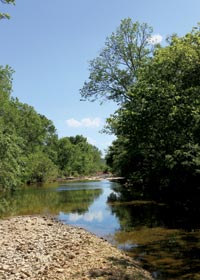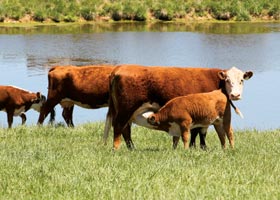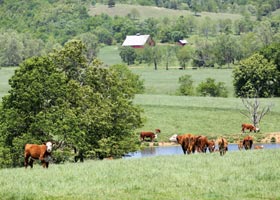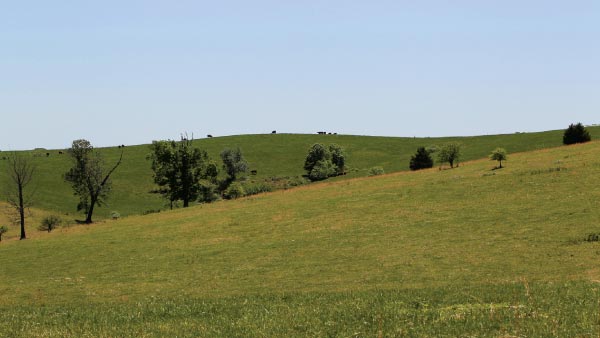The brawny Ford F-350 truck bounced and bumped over the off-road terrain as its driver expertly maneuvered around rocks and through high grass.
As the truck came into their sight, mahogany-and-white cattle — who were already keeping a distance —preferred to high-tail it even further away from the vehicle and its occupants.
The truck climbed up, up and more up until it reached the top of a slope.
The passengers got out and looked at the view that stretched in every direction: undulating hills, lines of tall trees and cows with their newborn calves. A requisite red barn completed the pastoral scene.
This is Journagan Ranch, a 3,300-acre cattle operation in Douglas County.
And it’s now a part of Missouri State University.
The second-largest single gift in University history

Leo Journagan and his family have given Missouri State the second-largest single gift in the University’s history: A working ranch complete with buildings, equipment and cattle.
The gift was announced to the public in February. The University now has full access to the ranch, but the official transfer of property and other assets will occur in phases over several years.
Academic programs at the ranch are expected to start in fall 2010. The ranch is about 60 miles from the Springfield campus and about 10 miles from the Mountain Grove campus.
This gift is taking education at the William H. Darr School of Agriculture to a new level by connecting the urban Springfield campus to a rural setting.
“My description of the ranch cannot do it justice — its size, its beauty and its potential are beyond my words,” Dr. Michael T. Nietzel, president of Missouri State, said.
“It is a special, special place and we are very appreciative. I am not overstating the impact when I say that this gift will transform the agriculture program for our students.”
Leo, the founder of Journagan Construction Company, has been buying the parcels of land that make up the ranch since the mid-1960s. He bought the first plot from a friend after they went turkey hunting there together. No one in the family can recall how many individual parcels he has purchased.
“The last piece he bought just a few years ago. We kept trying to make him stop,” his son, Allen, said with a laugh. “It got to the point that he wouldn’t even tell us when he bought more land. We would just see an area being cleared, more fences being built — and then the boundaries would move a bit further.”
Leo displays his characteristic sense of humor when discussing how he decided which land to buy: “You just have to look and see which parcel has the most rocks on it; that’s the one you want to get.”
Story behind the gift: “After this decision, I feel good”
Leo and his family — wife Jean, son Allen and daughter Jill — wanted to make sure the land would stay together long into the future.
“I’ve been thinking about giving the ranch as a gift for a long time, but could never make up my mind to finally give the place away,” Leo said. “After this decision, I feel good.”
Allen now runs Journagan Construction. He and Jill are thrilled that their father’s legacy will be maintained.
“We have so much respect for what Leo has accomplished there, but (cattle ranching) just isn’t for us,” Allen said. “It was coming down to two choices: sell the ranch or make a gift of it. I knew my dad would want to see the operation continue.”
The family had considered giving the ranch to conservation groups and other schools. Missouri State became a serious contender in 2007 after Journagan Construction did some paving and other work at the Darr School of Agriculture as a gift to the University. The Journagans had been supporters of Bear athletics, but this gave them a chance to get to know some of the agriculture professionals.
“As we spoke with more people at the University, we realized they shared our vision,” Allen said.
The family continued to mull their options until spring 2009. That was when Dr. Anson Elliott, head of the Darr School of Agriculture, had an impulse to see Allen: “It kept gnawing at me; I just felt I needed to go see him.” Anson set up a chat.
At the meeting, Allen told Anson to sit down: “He said we have some things to visit about.”
Allen wanted to know more about MSU’s agriculture program: Is there an emphasis on beef production? Yes, Anson said. What about forestry and wildlife management? We have a major in that very field, Anson told him.
“He smiled at my answers because I guess they paralleled what his father would like,” Anson said. “I had no idea what he was thinking, and it’s a good thing because I would have got all wobbly kneed.”
Allen told Anson the news: Leo was thinking of doing something with the ranch. The family wanted to give it to a school that could stress both economic sustainability and environmental responsibility.
“He asked me if we would have an interest in a potential donation,” Anson said.
“I told him: ‘This is what we have been waiting for.’”
The assets of the ranch, including a special cattle herd
The ranch is a massive gift.
First, there is the land itself. The 3,300-plus acres stretch over about seven miles. There are hills, woods, creeks, ponds, pastures, cropland and just about every other kind of natural phenomenon you would expect in southwest Missouri. Animals that have been spied on the property include bald eagles, bobcats, deer, hawks, owls, quail and turkey.
The ranch has almost limitless possibilities for University research in topics including biology, forestry, geology, genetics, plant science, soil quality and erosion, water quality and wildlife conservation. There may also be opportunities for the University to invite alumni or the public to hikes or horseback riding.

Second, there is equipment. The ranch has barns, buildings, vehicles, machinery and everything else a modern operation needs.
But the part of the gift that really makes Anson light up is the cattle.
Journagan Ranch has some crossbred cattle, but the main focus of the operation is purebred Polled Herefords, a variation of Hereford cattle without horns. The ranch has the 15th-largest herd of Polled Herefords in the United States.
There are about 1,000 cattle on the property; 243 were in the initial gift to the University and more will pass to MSU in stages. With this transfer, Missouri State has one of the largest Hereford herds associated with a university in the United States.
Marty Lueck, who has been the ranch manager since 1981, has developed a Hereford bloodline that is immensely respected in his industry.
“I tried to take the traits and make them better,” Lueck said. Herefords are known for being docile and for their ability to thrive in any environment. Journagan Ranch cattle are tough enough to handle Missouri’s icy winters and blistering summers. They have adapted to eat a diet primarily made of fescue, a common pasture grass, and naturally occurring legumes — meaning ranchers spend less on supplemental food.
These Herefords are also bred with a focus on fertility: The ranch wants females that conceive easily, deliver calves easily and are highly maternal.
Lueck and his team, which now consists of five employees, have sold either animals or genetic material (such as semen) to ranchers in 40 states, Canada and Mexico.
“Without Marty we wouldn’t have had any success, I imagine,” Leo said. “Marty’s the best in the cattle business I have ever seen. You can show him a picture of one of our animals and he can tell you where she came from, her age and, a lot of times, who her parents were. He just knows the cattle. And he’s got a lot of good people who work for him, too.”
Lueck will stay on as the manager as the ranch becomes part of the University. He already has ties to the school — he was a pre-veterinary student here in the 1970s and has had contact with MSU agriculture professionals throughout his career.

Students will have the chance to work alongside Lueck and his team. They will see the seven-days-a-week operations of a working ranch, including delivering calves, giving veterinary care and getting the animals ready for sale at stockyards and auctions.
“I hope the students can draw from my experience and maybe avoid some of the pitfalls that can come in their first years in the field. I can teach them about marketing, breeding and how to be frugal,” Lueck said. “Leo and I both believe in young people. This donation will give the school an advantage and give students real-life experience.”
Leo, Jean, Allen and Jill — as well as Marty and his wife, Vicki — have the thanks of many at Missouri State, but they are quick to deflect the praise.
“This is not about the Journagans,” Allen said. “It’s about the possibility of that ranch serving as a classroom. This is a gift to an institution that can put it to use to best educate future agriculture leaders.”


Great Philanthropic effort by Journagan’s Family, gifting the ranch that can be used for the benefit of MSU students
I think this gift can also be utilized for Auyurvedic Studies apart from agriculture and other Science majors
Thanks.
Wow – if I were able to get both feet off the ground at the same time, I’d be jumping up and down. This is absolutely wonderful and it’s always great to see people bless others through their generosity. My parents were John and Anna Carter – I graduated from Lead Hill in 1946. My husband and I spent our working careers on college campus and we can imagine what the gift will do for the college there.
This story means a lot to me. I have lived in Mountain Grove for over sixty years and grew up on a small farm in Douglas County, MO. I graduated from Ava High School and knew of the Journagan Family. This is what America is all about and life in Southwest and South Central Missouri is wonderfully enhanced by this marvelous gift to the University. Truly this is God’s Country. What a heritage for our children and grandchildren to live here.
The Journagan Family’s gift to Missouri State is a tremendous example of “paying it forward.” Their philanthropic legacy will benefit a multitude of students and perserve the natural beauty of the ranch, which ensures future generations the opportunity to experience the real Missouri. Mr. Journagan you should feel very good! Thank you, thank you, thank you!
A very wonderful thing that the Journagan’s have done. I do hope that they set up tours for the public. My wife and I want to come and see the ranch.
i bought a bull and a heifer off journagan’s they were 1500 a piece
I got to visit the Journagan Ranch for the first time this past weekend for the Wagons and Wine Benefit Trail Ride, and had been itching to since attending the press conference about the gift. Even through the driving rain I could see what a wonderful place Missouri State has been given. I hope that agriculture students from around the country get the chance appreciate it.